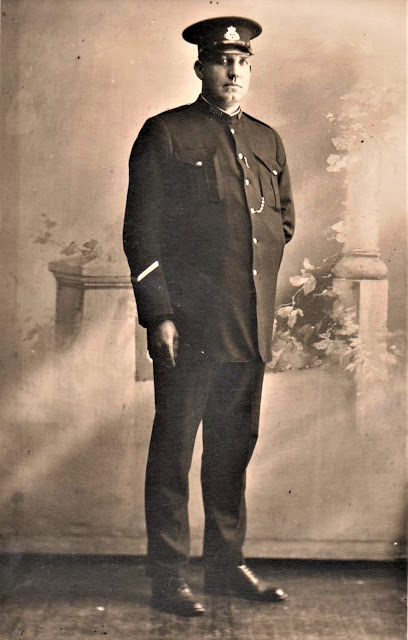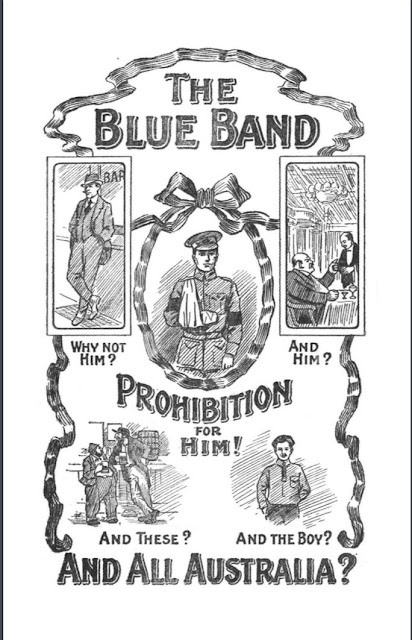John Enias McDonnell Harcombe - Lawkeeper to Lawbreaker!
From just a photo and a name on the back we found him! The mystery started back in October last year when I was given a photo with only the name ‘Jack’ on the back of the photo, the question, can we identify him?
 |
| Constable First Class John Harcombe |
So up on our Murringo First Families Facebook page he went hoping that someone may know who he is. He was quite a tall strapping man dressed in an NSW Police Uniform, the number 959 on his collar, one chevron on his lower sleeve. But what era was he from, was the number on his collar his badge number or collar number, and apparently there is a difference, the same as the chevron on his sleeve jacket which was lower down near his cuff instead of up higher as in later years of NSW Police Uniforms.
We received so many comments on ‘Jack’. He obviously was a member of the police force but who, when and where? We had current and ex-serving police members, army personnel, historians and the arm-chair enthusiasts giving invaluable advice, sharing the post and doing some searching of their own. And so, I also set off to find ‘Jack’ armed with all of the clues I could find. First off to work out what era he belonged to and the general consensus was that he was from between 1905-1930, 25 years sounds a lot, but in genealogy circles not so much. After doing a bit of research on NSW Police Uniforms I narrowed it down to 1911-1918, specifically the Metropolitan Foot Police Uniform. A hint, but not much else without a name. So, after going down rabbit holes for a while I asked the source of the photo to have another look and see if there was anything else, they had that might give more than the name Jack. And to my surprise and theirs as well they discovered the name Harcombe on another photo of the same man but in this picture, he was much younger and not in uniform.
 |
| John c1909 |
Brilliant, so now armed with the name of ‘Jack’ Harcombe I’m off and running looking for information. Couple of weeks go by and getting a bit frustrated, free access Police Employment records only go to 1885 and the Registers of Police on the NSW State Archives online search only go to 1913, and he’s not appearing anywhere, then I started noticing a trend in the searching. I’m not getting anything for a ‘Jack’ Harcombe but there are plenty of Trove articles on a Policeman named John Harcombe. Could this be him?
 |
| John c1916 |
So many hours and many weeks searching and a gazillion (okay slight exaggeration) cups of coffee later, Eureka! I found him.
John Enias McDonnell Harcombe, now there is a moniker for you, was born to George Harcombe and Marcella McDonnell on the 10th January 1893 at the family’s home of ‘Thornwell’ in the Marengo District.
John came from ‘good stock’ as the old saying goes. His father George was only 6 years old when he arrived in Australia with his parents who come from a long line of Agricultural Labourers from Somerset, England. His Mother’s family hail from Scotland and here he also descends from a proud line, ones who served both King Charles 1st and 2nd, another ancestor even fought on the side of ‘Bonny Prince Charlie’ at the ‘Battle of Culloden’ where he sadly perished, while his son fought in a Cavalry Regiment on the British side! I can’t imagine what that must have been like for the family, especially the wife and mother of the pair!
 |
| John's 4x great grandfather (Clan McDonnell) fought and died at the Battle of Culloden |
John married a local girl Margaret Ann Crowe, daughter of Michael Crowe and Mary Kennemore (both old established families from the district) at the Sacred Heart Catholic Church at Murringo in 1916 and they soon started a family.
 |
| Sacred Heart Catholic Church, Murringo - 2019 |
John had an uncle that served in WW1, four brothers who were cousins of John’s joined up in WW2, an older brother that had joined the NSW Police Force in 1908, so with such a distinguished family line it seems fitting that John would enlist at the age of 24 in the NSW Police Force. He joined on the 27th March 1917, Badge No: 337 as a Probationary Constable. This is during WW1 when our soldiers where fighting and dying on the other side of the world, Billy Hughes was Prime Minister and there was a movement to follow the USA with Prohibition.
 |
| Temperance Poster from the Prohibition Year Book 1918 |
The 1920’s are associated with the term ‘roaring twenties’, and we as a nation were changing – “The 1920s heralded the brave new world that emerged from the devastation of World War I. Australia’s allegiance to the British Empire’s war effort had come at a high price: thousands of young men had been slaughtered, families had been dislocated, and returned soldiers often struggled to fit back into the rhythms of society. Similar stories played out in other countries around the globe. Eager to put the horror and drudgery of war behind them, people began rebuilding their lives. The Roaring Twenties saw dramatic changes in technology, entertainment, architecture and society. Young women sought new freedoms, movies began influencing the way people lived, and technological developments such as faster, more reliable motor cars improved the lives of millions. Change brought opportunity, and criminals around the world found ways to cash in on developing illegal markets. Police forces, their numbers reduced by war, were caught on the back foot. Their work was made harder by the fact that laws did not always keep up with the pace of criminal evolution”. (https://sydneylivingmuseums.com.au/underworld/roaring-twenties)
Sydney had lost so many policemen to the battlefields of World War 1 that the Commissioner of Police in 1920 testified that the ‘force was between 200 and 300 men short of the number needed to do the job effectively’. With resources stretched, police struggled to maintain law and order in an environment where criminal behaviour was starting to take a stronghold. This was the time of the ‘Razor Gang’ Wars, prostitution rackets, cocaine distribution, sly grog trade and SP bookies. Criminals were thriving and the police, even those not on the take, were unable to stop them. Truth newspaper declared in 1929, “Crime in Sydney has become an organised profession.” (http://www.sydneycrimemuseum.com). Adding fuel to the fire, Australia was in the grip of a depression following World War 1 and with unemployment so high, honest work was hard to come by and pay was good for those willing to walk on the ‘wild side’ of life.
 |
| Kate Leigh - the sly-grog Queen of Sydney |
And it was into this seething cesspool of gangs, organised crime groups both international and domestic, sly grog sales, drug dealers and petty criminals that John Enias McDonnell Harcombe was thrust. John seems to have been stationed in the Metropolitan area of Sydney and he attained the rank of Constable 1st Class by 1925. He held this rank until 1935 and then it seems it all went terribly wrong.
John described as a mechanic had been attached to the Hurstville Police Station since 1932 as a driver of the Hurstville P.D. car.
 |
| P.D. Car from mid 1920s in Sydney, John probably drove one of these |
On the 17th November 1935 he was caught and charged with breaking, entering and stealing goods from a number of shops around the Hurstville area. It seems he often worked night shifts alone and had keys to various stores and just helped himself over a 12-month period. A large number of the goods were found neatly boxed and stacked up in the back of his garage. He immediately lost his position within the police force including all service rights and was committed for trial in early February of 1936. On the 12th of February at the Quarter Sessions at Kogarah Police Court before Judge White his crimes were outlined and while much sympathy was bestowed upon him by fellow officers the judge believed he had no choice but to deliver a prison sentence. He received 18 months, to be served at a prison farm.
 |
| Sydney Morning Herald article on John Harcombe's court appearance |
After serving his time, he returned home to his wife and found employment as a labourer and then as a Iron Workers Assistant.
John Enias McDonnell Harcombe passed away on Christmas Eve in 1957 at Rockdale in Sydney, just shy of his 65th birthday. He is buried in the Roman Catholic section of the Woronora Cemetery at Sutherland, with his wife Margaret who joined him 25 years later in 1982.
To me ‘Jack’ has become a bit of a conundrum; when caught he was honest about what he had done, showed the police where he stored the stolen items (he had kept nearly all of it), he came from a good family, had a loving wife who stood by him until the day he died, his superiors spoke well of him, he had good record of service in the Force, by all accounts he was well liked by the public, had served the community well for over 18 years as a Policeman, so I have to wonder what made the law-keeper become a law-breaker? Was it the times we lived in, was it that he saw the criminal element becoming more entrenched into every part of society, was it that he knew of other corrupt police and thought ‘why not’, was it for ‘thrills’ or was a simple case of he saw, he wanted, he could, so he did.
If you know any more about John Enias McDonnell Harcombe please get in touch with Murringo First Families.
What a great story!! Really enjoyed reading it, Sorry it's taken this long to do so.
ReplyDelete